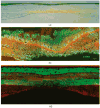Lutein, zeaxanthin, and meso-zeaxanthin: The basic and clinical science underlying carotenoid-based nutritional interventions against ocular disease
- PMID: 26541886
- PMCID: PMC4698241
- DOI: 10.1016/j.preteyeres.2015.10.003
Lutein, zeaxanthin, and meso-zeaxanthin: The basic and clinical science underlying carotenoid-based nutritional interventions against ocular disease
Abstract
The human macula uniquely concentrates three carotenoids: lutein, zeaxanthin, and meso-zeaxanthin. Lutein and zeaxanthin must be obtained from dietary sources such as green leafy vegetables and orange and yellow fruits and vegetables, while meso-zeaxanthin is rarely found in diet and is believed to be formed at the macula by metabolic transformations of ingested carotenoids. Epidemiological studies and large-scale clinical trials such as AREDS2 have brought attention to the potential ocular health and functional benefits of these three xanthophyll carotenoids consumed through the diet or supplements, but the basic science and clinical research underlying recommendations for nutritional interventions against age-related macular degeneration and other eye diseases are underappreciated by clinicians and vision researchers alike. In this review article, we first examine the chemistry, biochemistry, biophysics, and physiology of these yellow pigments that are specifically concentrated in the macula lutea through the means of high-affinity binding proteins and specialized transport and metabolic proteins where they play important roles as short-wavelength (blue) light-absorbers and localized, efficient antioxidants in a region at high risk for light-induced oxidative stress. Next, we turn to clinical evidence supporting functional benefits of these carotenoids in normal eyes and for their potential protective actions against ocular disease from infancy to old age.
Keywords: Age-related macular degeneration; Carotenoid; Lutein; Macular pigment; Nutrition; Zeaxanthin.
Copyright © 2015 Elsevier Ltd. All rights reserved.
Figures















References
-
- Abadi RV, Cox MJ. The distribution of macular pigment in human albinos. Investigative ophthalmology & visual science. 1992;33:494–497. - PubMed
-
- Acton S, Rigotti A, Landschulz KT, Xu S, Hobbs HH, Krieger M. Identification of scavenger receptor SR-BI as a high density lipoprotein receptor. Science. 1996;271:518–520. - PubMed
-
- Age-Related Eye Disease Study 2 Research, G. Lutein + zeaxanthin and omega-3 fatty acids for age-related macular degeneration: the Age-Related Eye Disease Study 2 (AREDS2) randomized clinical trial. JAMA. 2013;309:2005–2015. - PubMed
-
- Chew EY, Clemons TE, Sangiovanni JP, Danis RP, Ferris FL, 3rd, Elman MJ, Antoszyk AN, Ruby AJ, Orth D, Bressler SB, Fish GE, Hubbard GB, Klein ML, Chandra SR, Blodi BA, Domalpally A, Friberg T, Wong WT, Rosenfeld PJ, Agron E, Toth CA, Bernstein PS, Sperduto RD Age-Related Eye Disease Study 2 Research, G. Secondary analyses of the effects of lutein/zeaxanthin on age-related macular degeneration progression: AREDS2 report No. 3. JAMA ophthalmology. 2014;132:142–149. - PMC - PubMed
-
- Chew EY, SanGiovanni JP, Ferris FL, Wong WT, Agron E, Clemons TE, Sperduto R, Danis R, Chandra SR, Blodi BA, Domalpally A, Elman MJ, Antoszyk AN, Ruby AJ, Orth D, Bressler SB, Fish GE, Hubbard GB, Klein ML, Friberg TR, Rosenfeld PJ, Toth CA, Bernstein P Age-Related Eye Disease Study 2 Research, G. Lutein/zeaxanthin for the treatment of age-related cataract: AREDS2 randomized trial report no. 4. JAMA ophthalmology. 2013;131:843–850. - PMC - PubMed
Publication types
MeSH terms
Substances
Grants and funding
LinkOut - more resources
Full Text Sources
Other Literature Sources
Medical

